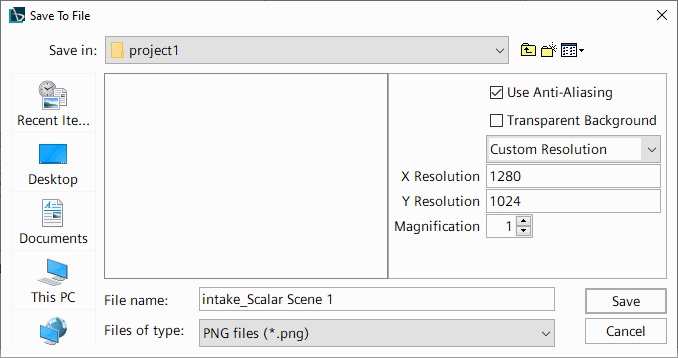The versatile scene exporting capabilities of Simcenter STAR-CCM+ give you a wide range of choices for visualizing solution
results. You can save scenes to any one of various image file types as either a single
action or at regular intervals during the simulation run. As an alternative to writing
static image files, you can export scenes to an MP4 file, building an animation while a
solution progresses (particularly transient solutions).
For interaction with a scene showing
solution results in 3D, you can write scenes to the .sce file
format which can be subsequently read using Simcenter STAR-CCM+ Viewer (or its online counterpart). For details, see Exporting an Interactive 3D Scene.-
To export one or more scenes to an image file:
-
Select one or more [scene] nodes (using <Ctrl><Click> for multiple nodes).
-
Right-click one of the selected nodes and select Hardcopy.
-
In the Save To File dialog, provide a File Name and file type.
-
Set the output resolution using the X Resolution and Y Resolution properties.
When you save multiple scenes, the settings specified in the Save To File dialog are applied to all scenes. The image files are saved under the name provided in the File Name text box and numbered incrementally according to their position in the simulation tree. In the example shown in the above screenshots, the image files would be named intake-scene_0.png, intake-scene_1.png, and intake-scene_2.png, which correspond to Geometry Scene 1, Mesh Scene 1 and Scalar Scene 1 respectively.
While you cannot export multiple scenes to a single MP4 file, you can
export them to separate MP4 files. Once the simulation run is
finished, you can then combine them manually using a movie editor of
your choice.
During a simulation run, Simcenter STAR-CCM+ can write scene hardcopies to disk with a frequency that you specify. If you write these hardcopies to a .sce file, you can use the scetopng utility from the installation to export individual hardcopies in the .png format.
-
To save scene images automatically during a simulation:
-
For each scene that you want to save to an image or Viewer file, select
the node and set File Format to one
of the available options.
If you are running a simulation in batch mode on a
cluster, you are advised to use the sce
option (a Simcenter STAR-CCM+ Viewer
file).
-
Activate Save To File.
-
Complete the Output Directory and Base Filename properties.
The sce option allows you to append scenes to the same file each time, but for other formats, Simcenter STAR-CCM+ appends a numeric count to the Base Filename.
-
If you chose the .sce option, and you wish to append scenes to the same
file, select the node and activate Append.
For a Viewer file, you can also provide a title and
description that applies to each exported scene.
-
For all output formats apart from
sce, select the node and set the other properties. These include Output Width and Output Height by which you can control the resolution of the image.
When your simulation is complete, you have a variety of options for working
with the output: can work with the output:
- If you exported the scenes to an MP4 file, you can view the resulting
file to examine the simulation results as they change.
- If you exported the scenes to static images, you can examine individual
images from various instances in the solution easily. At the same time,
you can still create an animation from the image files using a
movie-creation utility of your choice.
- If you wrote the scenes to
.sce files, you
can first export each scene as an individual .png file
using the scetopng utility. For details, see Viewer File
Transform Utility scetopng.
